It looks like you're using an Ad Blocker.
Please white-list or disable AboveTopSecret.com in your ad-blocking tool.
Thank you.
Some features of ATS will be disabled while you continue to use an ad-blocker.
share:
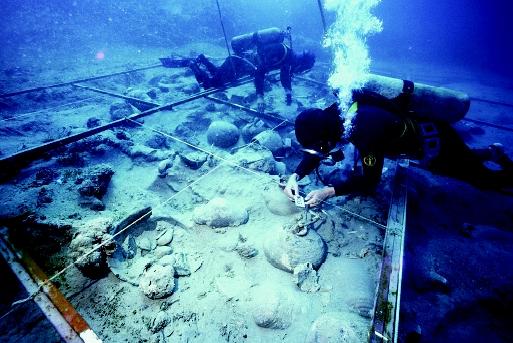
Discovered nearly thirty years ago the ship was from the late Bronze age. She is best remembered for the wide variety of trade goods she carried. Items from 11 different cultures
Discussion of what the ship's cargo told us about 14th BCE trade routes
From this image below you can see how the cargo was stored
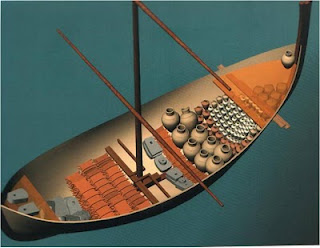
This cargo consisted of:
Copper and tin ingots Raw copper cargo totaling ten tons, consisting of a total of 354 ingots of the oxhide
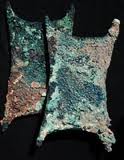
At least 149 Canaanite jars (widely found in Greece, Cyprus, Syria-Palestine, and Egypt).
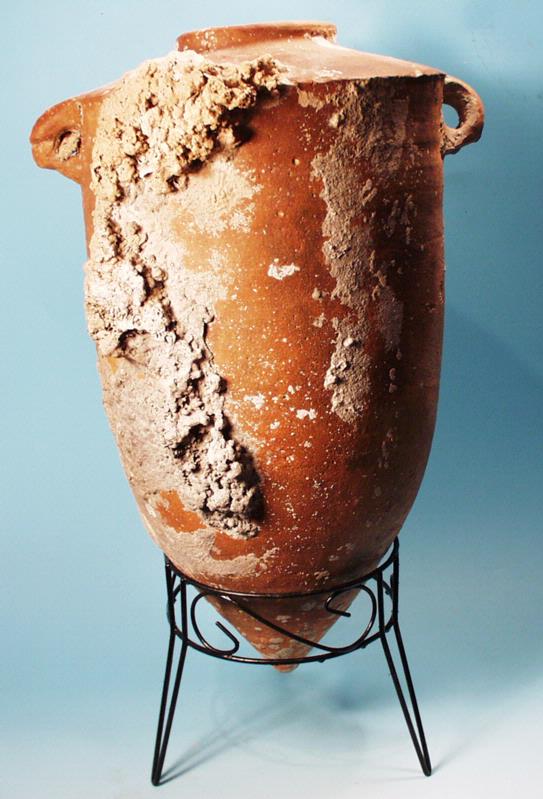
Jars are categorized as the northern type and were most likely made somewhere in the northern part of modern-day Israel.
One jar filled with glass beads, many filled with olives, but the majority contained a substance known as Pistacia (terebinth) resin.
Approximately 175 glass ingots of cobalt blue turquoise and lavender were found (earliest intact glass ingots known). Chemical composition of cobalt blue glass ingots matches those of contemporary Egyptian core-formed vessels and Mycenaean pendant beads, which suggests a common source.
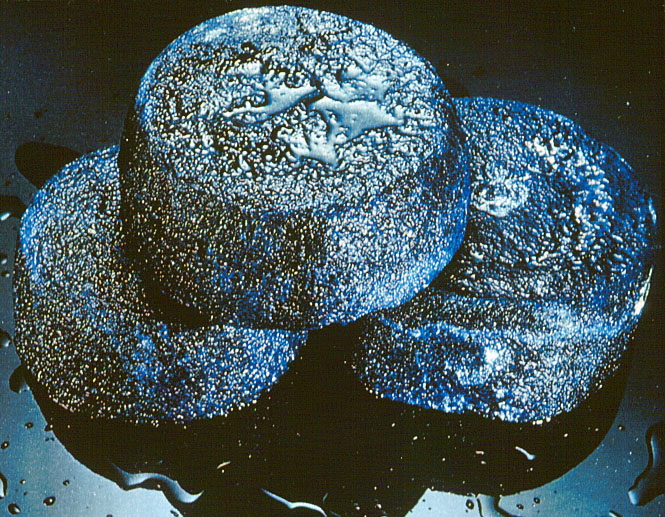
Also included were
Logs of blackwood from Africa (referred to as ebony by the Egyptians)
Ivory in the form of whole and partial elephant tusks
More than a dozen hippopotamus teeth
Tortoise carapaces (upper shells)
Murex opercula (possible ingredient for incense)
Ostrich eggshells
Cypriot pottery
Cypriot oil lamps
Bronze and copper vessels (four faience drinking cups shaped as rams’ heads and one shaped as a woman’s head)
Two duck-shaped ivory cosmetics boxes
Ivory cosmetics or unguent spoon
Trumpet
More than two dozen sea-shell rings
Beads of amber (Baltic origin)
Agate
Carnelian
Quartz
Gold
Faience
Glass
It also carried
Collection of usable and scrap gold and silver Canaanite jewelry
Biconical chalice (largest gold object from wreck)
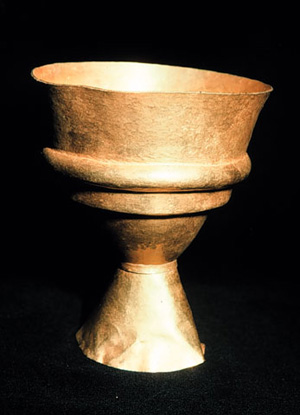
Egyptian objects of gold, electrum, silver, and steatite (soap stone)
Gold scarab inscribed with the name of Nefertiti
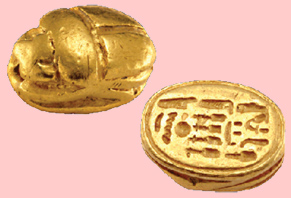
Bronze female figurine (head, neck, hands, and feet covered in sheet gold)
A book with wax pages
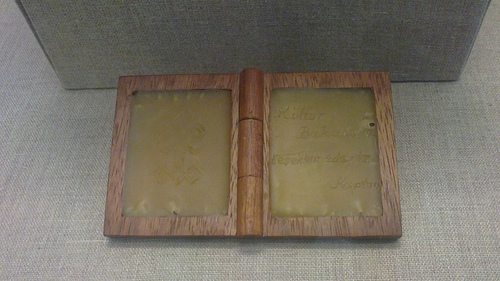
An image showing where some of the cargo came from
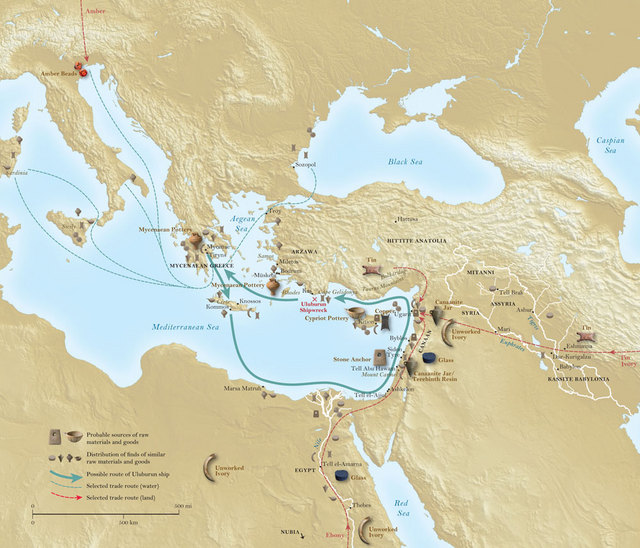
The ship was dated by
Peter Kuniholm of Cornell University was assigned the task of dendrochronological dating in order to obtain an absolute date for the ship. The results date the wood at 1305 BCE, but given that no bark has survived it is impossible to determine an exact date and it can be assumed that the ship sank sometime after that date. Based on ceramic evidence, it appears that the Uluburun sank toward the end of the Amarna period, but could not have sunk before the time of Nefertiti due to the unique gold scarab engraved with her name found aboard the ship.For now, it is concluded that the ship sank at the end of the 14th century BCE.
Link to Link to more images of the cargo
posts like this are why i originaly came to ats thank you well presented and sourced seems the ancients really got around
Great find, I love the wax book, the hinges look like a modern laptop and the reusable wax was a great idea. Always amazed by how complex they were
3,400 years ago. Thank you for bringing it to my attention and the extra pics will keep me amused for some time.
Wow , great find. Looks like the Mediterranean was a hopping place back in the bronze age. Those items would be valuable even today. Some trader must
have been crying in his beer when it went down. Excellent post S&F.
I don't often comment on rare finds, but this, this is the most beautiful and amazing collection by far.
i'll take a one of each Thank You
love and harmony
Whateva
i'll take a one of each Thank You
love and harmony
Whateva
Agree with the poster above: We desperately need more posts like this. I am almost getting mind rot from all the political banter, the religion/no
religion, the prolife/choice and war/no war, 1%/99% posts constantly non stop all the time 24/7.
Posts like this let me relax. To not think about the ills going on in the world for a while. Posts like this let me slip back to a time eons ago where life was hard, but nothing like now. Posts like these are a huge blast of badly needed clean Soul Oxygen.
I ate this up. The pics, the story, all of it. I think I'll stay in this category - or whichever categories talk about history found etc., and do a soul/mind/brain reset and cleanse.
The normal drivel on here will sadly still be here if I decide to re-enter that world.
Right now I need to indulge in some ancient castles, ancient egyptians, ancient Norman ruins, etc.
Seriously; things and people which once WERE are not dangerous like the things and people who currently are NOW.
Posts like this let me relax. To not think about the ills going on in the world for a while. Posts like this let me slip back to a time eons ago where life was hard, but nothing like now. Posts like these are a huge blast of badly needed clean Soul Oxygen.
I ate this up. The pics, the story, all of it. I think I'll stay in this category - or whichever categories talk about history found etc., and do a soul/mind/brain reset and cleanse.
The normal drivel on here will sadly still be here if I decide to re-enter that world.
Right now I need to indulge in some ancient castles, ancient egyptians, ancient Norman ruins, etc.
Seriously; things and people which once WERE are not dangerous like the things and people who currently are NOW.
reply to post by sarra1833
Yes I agree on the low quality of posts in many of the other sub-forums!
Now I put up this Ship wreck because I noted the story below;
Looking for a ship older than the Uluburun wreck
No one has found a Minoan ship wreck and the competition to be the first is fierce.
Looking for old wrecks
Another point in 1994 I visited the Bodrum Museum of Underwater Archaeology in Southern Turkey. Located in the old Bodrun castle it holds one of the finest collection of ancient wreck archaeology
One of the best ancient wreck museums
Yes I agree on the low quality of posts in many of the other sub-forums!
Now I put up this Ship wreck because I noted the story below;
Looking for a ship older than the Uluburun wreck
..... His four-week survey of the waters around Crete last October is part of a long-term effort to catalogue large numbers of ancient shipwrecks in the Aegean Sea. And the grand prize would be a wreck from one of the most influential and enigmatic cultures of the ancient world — the Minoans, who ruled these seas more than 3,000 years ago.
No one has found a Minoan ship wreck and the competition to be the first is fierce.
Looking for old wrecks
Another point in 1994 I visited the Bodrum Museum of Underwater Archaeology in Southern Turkey. Located in the old Bodrun castle it holds one of the finest collection of ancient wreck archaeology
One of the best ancient wreck museums
edit on 28/1/12 by Hanslune because: (no reason given)
Thanks for this thread and all the pictures. I enjoyed reading about them and seeing the items.
I am wondering. Were the 175 glass ingots of cobalt blue turquoise and lavender for jewelry purposes? It wasn't a form of currency like diamonds or gems were they? I'm just trying to get a better understanding of how such objects were valued or used since I'm not familiar with it.
I am wondering. Were the 175 glass ingots of cobalt blue turquoise and lavender for jewelry purposes? It wasn't a form of currency like diamonds or gems were they? I'm just trying to get a better understanding of how such objects were valued or used since I'm not familiar with it.
Amazing stuff! The golden scarab really interests me, then again a lot of the ancient gold stuff does. For something that we consider so valuable
today and we rarely see in large quantities other than gold bars, it's amazing to see it used in fairly large decorative pieces.
reply to post by Hanslune
Awesome and amazing!
Thank you!
It's a fantastic wonder all found has been laying around underwater for 3400 years.
It's wonderful that after all that time gone by, researchers can still tell what perishable items were stored.
It makes one wonder about the possibilities of other wrecks, remains, and even whole cities and towns submerged underwater and preserved, forgotten.
Göbekli Tepe was active toward end of last ice age ~11,000
Sea levels were near 400' or about 120m lower than now. I'd imagine if Göbekli Tepe was possible 11,000 years ago, certainly coastal settlements that would now be covered in 400 feet of water, miles off current coast lines in some cases, would be possible.
Imagine something preserved like Pompeii, but as old as Göbekli Tepe.
Awesome and amazing!
Thank you!
It's a fantastic wonder all found has been laying around underwater for 3400 years.
It's wonderful that after all that time gone by, researchers can still tell what perishable items were stored.
It makes one wonder about the possibilities of other wrecks, remains, and even whole cities and towns submerged underwater and preserved, forgotten.
Göbekli Tepe was active toward end of last ice age ~11,000
Sea levels were near 400' or about 120m lower than now. I'd imagine if Göbekli Tepe was possible 11,000 years ago, certainly coastal settlements that would now be covered in 400 feet of water, miles off current coast lines in some cases, would be possible.
Imagine something preserved like Pompeii, but as old as Göbekli Tepe.
Very good post. It still amazes me that archaeologists keep trying to promote the lack of long distance trading in the BC times. It's because of
finds like these that make them seriously question their paradigm of ancient civilisations. I think at the present time Bob Ballard is searching the
Black sea for early stone age artifacts. That being the Black sea area was above sea level before the last ice age melt and the nature of the sea ie
high levels of saline in defined strata, making the preservation of artifacts almost pristine as when they were laid down. This also gives rise to the
inundation of the Black sea basin, when the mass of the ice age ice melted, was the insperation for the biblical flood myth. Even though the
archaeologist remain stubborn any-one could envisage a BC trader hugging the coasts around the Mediteranean and even into northern Europe via the
English channel or even South Africa without leaving the reassurance of keeping the coast in sight. More can only come with the better underwater
exploration technology.
I particularly like the cobalt glass blanks. These were clearly intended as raw materials, which means the ability to melt and reprocess them was more
widely spread in the bronze age than previously assumed!
Howdy Crayzeed
Are they?
Its archaeologists finding the stuff so as a group they are rather into the concept or trade. Even in the 19th century as archaeology took off as a science things were being found that showed there was trade between early civilizations/cultures. Easiest trade was in obsidian and chert for stone tools. The biggest debate about trade has been whether it is:
Direct access: cultures have direct access to each other
Down the line trade: cultures don't have direct access and they trade material through others, example chinese trading of silk to Rome thru numerous middle men
Central point: the cultures don't have direct contact but meet at a central point, ie traders have contact but are themselves isolated from their own cultures, example Roman trading colonies in India
Originally posted by crayzeed
Very good post. It still amazes me that archaeologists keep trying to promote the lack of long distance trading in the BC times.
Are they?
It's because of finds like these that make them seriously question their paradigm of ancient civilisations.
Its archaeologists finding the stuff so as a group they are rather into the concept or trade. Even in the 19th century as archaeology took off as a science things were being found that showed there was trade between early civilizations/cultures. Easiest trade was in obsidian and chert for stone tools. The biggest debate about trade has been whether it is:
Direct access: cultures have direct access to each other
Down the line trade: cultures don't have direct access and they trade material through others, example chinese trading of silk to Rome thru numerous middle men
Central point: the cultures don't have direct contact but meet at a central point, ie traders have contact but are themselves isolated from their own cultures, example Roman trading colonies in India
Nice thread , it reminds me of the days I have spent in Bodrum Castle museum.
I use to dive in and around the Bodrum peninsula .
I use to dive in and around the Bodrum peninsula .
Originally posted by 23432
Nice thread , it reminds me of the days I have spent in Bodrum Castle museum.
I use to dive in and around the Bodrum peninsula .
Do you remember a restaurant called (I believe) Eibekler Birahanesi near the old Hammam just inland from the castle?
gotta be honest here....the gold cup...i instantly saw harrison ford swooping in, cracking his whip and dashing off with the cup as egyptian nazi's
chase him around. gah....if only he were 30 years younger and i were a female...
back on topic...S&F mate! nice find..awesome presentation!
back on topic...S&F mate! nice find..awesome presentation!
edit on 1/28/12 by ICEKOHLD because: (no reason given)
I don't really have anything to add, but I just wanted to post in this thread to show my support for quality thread making.
This is information I probably would not have stumbled upon myself if it hadn't been for this thread.
This is information I probably would not have stumbled upon myself if it hadn't been for this thread.
Originally posted by Hanslune
Originally posted by 23432
Nice thread , it reminds me of the days I have spent in Bodrum Castle museum.
I use to dive in and around the Bodrum peninsula .
Do you remember a restaurant called (I believe) Eibekler Birahanesi near the old Hammam just inland from the castle?
I have left Bodrum in 1979 after high school.
The Hamam that we went was nearby Halikarnas and If my memory serves me right it was the only operational Hamam in Bodrum at the time .
There was a friend who's father was in charge of Bodrum underwater museum and that's how I have spent a lot of time in Bodrum castle while the museum was being set up . I believe the years it was 1977 - 78 .
I had many times came across a sunken ship of some sort or the other . Unfortunately in those days , the archeology was not really my cup of tea , so to speak .
My dad's company was bringing drinking water to Bodrum and as a result I ended up supervising 25 miles of channel digging from Bodrum to Turgutreis .
I take it that your knowledge of Bodrum is more recent then mine .
Bodrum is where I am going to spend my retirement years , hopefully .
edit on 28-1-2012 by 23432 because: (no reason given)
Uluburun started the the underwater archaeological craze, it has since become a huge market for wanna be archaeologists. An interesting point about
this site is that they found big ingots of gold at the ship wreck. The Neffertiti medallion is also very important because it shows that the ship was
in trade after the reign of Neffertiti. It is strange that they used dendrochronology for this ship. Usually archaeologists will use relative dating,
which dates an artifact in relation to other known artifact dates. Meaning they could have used the pots and compared the art on the pot or the style
the pot was made, and look at other known pot styles and art that have a date to create a reasonable date for this shipwreck. We studied this
shipwreck in my archaeology class last semester at KU.
Uluburun started the the underwater archaeological craze, it has since become a huge market for wanna be archaeologists. An interesting point about
this site is that they found big ingots of gold at the ship wreck. The Neffertiti medallion is also very important because it shows that the ship was
in trade after the reign of Neffertiti. It is strange that they used dendrochronology for this ship. Usually archaeologists will use relative dating,
which dates an artifact in relation to other known artifact dates. Meaning they could have used the pots and compared the art on the pot or the style
the pot was made, and look at other known pot styles and art that have a date to create a reasonable date for this shipwreck. We studied this
shipwreck in my archaeology class last semester at KU.
new topics
-
Cold Blooded Killers on Christmas!! GRRRRrrr!!
Pets: 4 hours ago -
Plane Crash Today --Azerbaijanian E190 passenger jet
Mainstream News: 9 hours ago
top topics
-
Orange County Makes Shoplifting a Felony
Other Current Events: 13 hours ago, 17 flags -
It's Offical Now
US Political Madness: 15 hours ago, 15 flags -
The reason it works is.....
General Chit Chat: 16 hours ago, 8 flags -
Cold Blooded Killers on Christmas!! GRRRRrrr!!
Pets: 4 hours ago, 7 flags -
Plane Crash Today --Azerbaijanian E190 passenger jet
Mainstream News: 9 hours ago, 6 flags
active topics
-
Plane Crash Today --Azerbaijanian E190 passenger jet
Mainstream News • 13 • : Boomer1947 -
Cold Blooded Killers on Christmas!! GRRRRrrr!!
Pets • 7 • : charlest2 -
Statements of Intent from Incoming Trump Administration Members - 2025 to 2029.
2024 Elections • 54 • : WeMustCare -
DefCon Teetering on Escalation
World War Three • 51 • : WeMustCare -
-@TH3WH17ERABB17- -Q- ---TIME TO SHOW THE WORLD--- -Part- --44--
Dissecting Disinformation • 3813 • : WeMustCare -
1 Billion dollars
General Entertainment • 13 • : ColeYounger2 -
It's Offical Now
US Political Madness • 15 • : Imhere -
Political Warfare & The Resister Special Forces Underground
Political Ideology • 2 • : NoCorruptionAllowed -
London Christmas Market BANS Word ‘Christmas’
Social Issues and Civil Unrest • 49 • : NorthOS -
Post A Funny (T&C Friendly) Pic Part IV: The LOL awakens!
General Chit Chat • 7956 • : KrustyKrab
